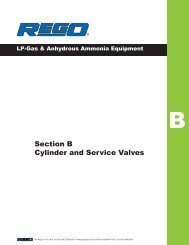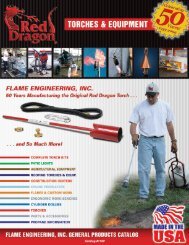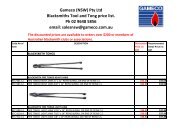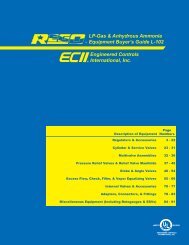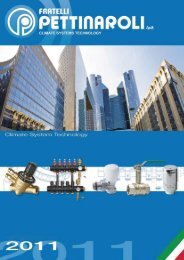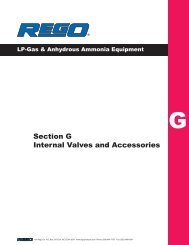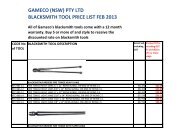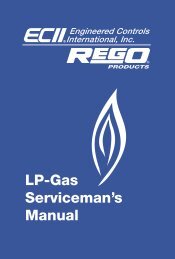Repair Kits Available By Part Number Section 2 Page - GAMECO
Repair Kits Available By Part Number Section 2 Page - GAMECO
Repair Kits Available By Part Number Section 2 Page - GAMECO
You also want an ePaper? Increase the reach of your titles
YUMPU automatically turns print PDFs into web optimized ePapers that Google loves.
WARNING: Installation, disassembly, repair and maintenance<br />
must be performed only by qualified personnel.<br />
All gas MUST be evacuated from the system before starting<br />
repairs.<br />
Installation, usage and maintenance of this product must<br />
be in compliance with all Engineered Controls International,<br />
Inc. instructions as well as requirements and provisions of<br />
NFPA #54, NFPA #58, DOT, ANSI, all applicable federal, state,<br />
provincial and local standards, codes, regulations and laws.<br />
Inspection and maintenance on a periodic basis is essential.<br />
Be sure all instructions are read and understood before<br />
installation, operation and maintenance. These instructions<br />
must be passed along to the end user of the product.<br />
CAUTION: Contact or inhalation of liquid propane, ammonia<br />
and their vapors can cause serious injury or death! NH3 and<br />
LP-Gas must be released outdoors in air currents that will<br />
insure dispersion to prevent exposure to people and livestock.<br />
LP-Gas must be kept far enough from any open flame or<br />
other source of ignition to prevent fire or explosion! LP-Gas<br />
is heavier than air and may not disperse or evaporate rapidly<br />
if released in still air.<br />
<strong>Repair</strong> Procedure<br />
CAUTION: READ THROUGH ALL OF THESE INSTRUCTIONS,<br />
INCLUDING THE NOTICE AND WARNINGS ON THE LAST PAGE<br />
OF THIS SHEET, BEFORE BEGINNING ANY DISASSEMBLY<br />
OR REPAIR.<br />
The Flomatic must be removed from the container before making<br />
repairs. The degree of valve disassembly will vary depending<br />
upon the repair kit used.<br />
It is important to compare the actual contents of your kit with those<br />
which should be present as indicated in the Key on page 3. Be sure<br />
all the parts are present before beginning repairs.<br />
Note: <strong>Repair</strong>s must be performed in a clean area. Hands, clothing,<br />
tools and work area must be completely free of oil, grease<br />
and foreign matter to prevent contamination of component<br />
parts and valves.<br />
Figure 1<br />
Upper Gasket<br />
45<br />
Mating Flanges<br />
7560-56<br />
Bolt Stud & Nut<br />
A7883FK and A7884FK<br />
Flomatic ® Internal Valves<br />
<strong>Repair</strong> Assemblies<br />
Removing Flomatic ® from Container<br />
Note: The Flomatic ® must be removed from the container before<br />
beginning repairs.<br />
1. PROPERLY EVACUATE ALL LIQUID AND VAPOR FROM THE<br />
SYSTEM BEFORE ANY DISASSEMBLY OR REPAIR.<br />
2. Remove the steel nuts from the steel bolt studs both above and<br />
below the mating fl anges.<br />
3. Remove the Flomatic from the container.<br />
4. Remove the gaskets from above and below the mating fl anges.<br />
Discard gaskets.<br />
Flomatic Disassembly – Figures 4A - 4D<br />
1. Turn the cap screws (#1) counterclockwise. Remove cap screws<br />
and lockwashers (#2).<br />
2. Remove the strainer (#3).<br />
3. Loosen the set screw (#5) located on the side of the cylinder.<br />
4. Carefully remove the cylinder (#4) by turning it counterclockwise<br />
and threading it off the body. Use caution when removing cylinder!<br />
The return spring (#6) will push the cylinder upward.<br />
5. Remove the loose return spring (#6) and screen fi lters (#7) from<br />
the top of the piston assembly (#8).<br />
6. Place the valve body in a horizontal position on a workbench<br />
to gain access to lower part of valve.<br />
7. Remove the piston retainer assembly (#15) by turning it<br />
counterclockwise until it disengages from the lower body.<br />
8. Remove the large piston and seat disc assembly (#8) from<br />
the top of the valve.<br />
9. Remove the packing nut assembly (#40) by turning it<br />
counterclockwise until it disengages from valve body and<br />
indicating stem (#36).<br />
10.Remove indicating stem (#36) by fi rst pulling it into the valve<br />
body, then pull it out through the top of valve.<br />
11.Remove fi lter (#10) by turning counterclockwise and discard.<br />
Servicing the Large Piston and Seat Disc Assembly (#8)<br />
Note: Carefully inspect the pilot piston (#26) and inside walls of<br />
cylinder (#4) before starting service. If any signs of wear, nicks, or<br />
gouges appear on either of these components, discard and replace<br />
that component. A smooth machined fi nish on the pilot piston and<br />
cylinder is essential for proper valve operation.<br />
X-Seal Replacement – Figures 4A and 4B<br />
1. Turn cap screws (#16) counterclockwise and remove.<br />
2. Lift off the X-seal retainer.<br />
3. Remove the X-seal (#17).<br />
4. Inspect area of piston where X-seal was removed. Carefully<br />
clean if necessary.<br />
5. Install new X-seal and replace the X-seal retainer.<br />
6. Reinstall cap screws and securely fasten. Follow tightening<br />
sequence shown in Figure 2.<br />
Lower Gasket<br />
46<br />
A7884F-43<br />
Bolt Stud<br />
& 2 Nuts<br />
PAGE 1



